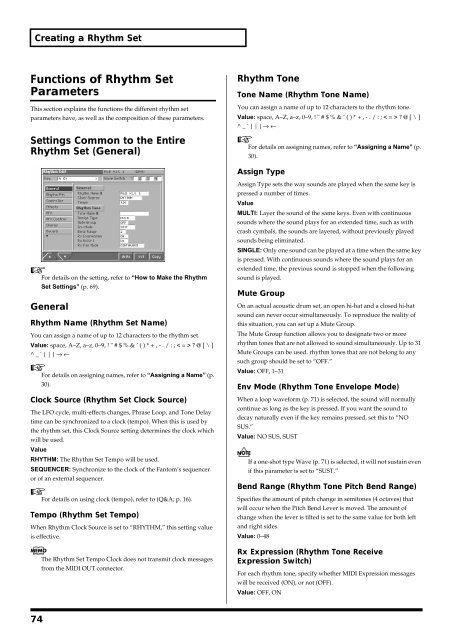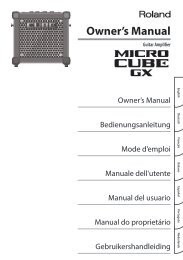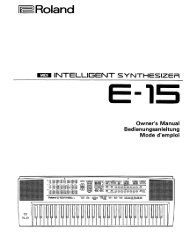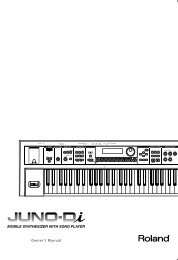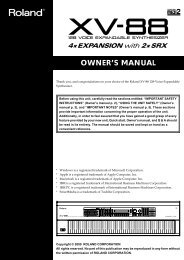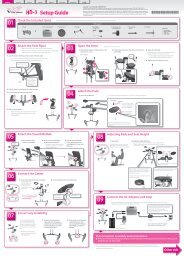FANTOM_OM.pdf - Roland
FANTOM_OM.pdf - Roland
FANTOM_OM.pdf - Roland
You also want an ePaper? Increase the reach of your titles
YUMPU automatically turns print PDFs into web optimized ePapers that Google loves.
Creating a Rhythm Set<br />
Functions of Rhythm Set<br />
Parameters<br />
This section explains the functions the different rhythm set<br />
parameters have, as well as the composition of these parameters.<br />
Settings Common to the Entire<br />
Rhythm Set (General)<br />
fig.04-10a_50<br />
74<br />
For details on the setting, refer to “How to Make the Rhythm<br />
Set Settings” (p. 69).<br />
General<br />
Rhythm Name (Rhythm Set Name)<br />
You can assign a name of up to 12 characters to the rhythm set.<br />
Value: space, A–Z, a–z, 0–9, ! " # $ % & ’ ( ) * + , - . / : ; < = > ? @ [ \ ]<br />
^ _ ` { | } → ←<br />
For details on assigning names, refer to “Assigning a Name” (p.<br />
30).<br />
Clock Source (Rhythm Set Clock Source)<br />
The LFO cycle, multi-effects changes, Phrase Loop, and Tone Delay<br />
time can be synchronized to a clock (tempo). When this is used by<br />
the rhythm set, this Clock Source setting determines the clock which<br />
will be used.<br />
Value<br />
RHYTHM: The Rhythm Set Tempo will be used.<br />
SEQUENCER: Synchronize to the clock of the Fantom’s sequencer<br />
or of an external sequencer.<br />
For details on using clock (tempo), refer to (Q&A; p. 16).<br />
Tempo (Rhythm Set Tempo)<br />
When Rhythm Clock Source is set to “RHYTHM,” this setting value<br />
is effective.<br />
The Rhythm Set Tempo Clock does not transmit clock messages<br />
from the MIDI OUT connector.<br />
Rhythm Tone<br />
Tone Name (Rhythm Tone Name)<br />
You can assign a name of up to 12 characters to the rhythm tone.<br />
Value: space, A–Z, a–z, 0–9, ! " # $ % & ’ ( ) * + , - . / : ; < = > ? @ [ \ ]<br />
^ _ ` { | } → ←<br />
For details on assigning names, refer to “Assigning a Name” (p.<br />
30).<br />
Assign Type<br />
Assign Type sets the way sounds are played when the same key is<br />
pressed a number of times.<br />
Value<br />
MULTI: Layer the sound of the same keys. Even with continuous<br />
sounds where the sound plays for an extended time, such as with<br />
crash cymbals, the sounds are layered, without previously played<br />
sounds being eliminated.<br />
SINGLE: Only one sound can be played at a time when the same key<br />
is pressed. With continuous sounds where the sound plays for an<br />
extended time, the previous sound is stopped when the following<br />
sound is played.<br />
Mute Group<br />
On an actual acoustic drum set, an open hi-hat and a closed hi-hat<br />
sound can never occur simultaneously. To reproduce the reality of<br />
this situation, you can set up a Mute Group.<br />
The Mute Group function allows you to designate two or more<br />
rhythm tones that are not allowed to sound simultaneously. Up to 31<br />
Mute Groups can be used. rhythm tones that are not belong to any<br />
such group should be set to “OFF.”<br />
Value: OFF, 1–31<br />
Env Mode (Rhythm Tone Envelope Mode)<br />
When a loop waveform (p. 71) is selected, the sound will normally<br />
continue as long as the key is pressed. If you want the sound to<br />
decay naturally even if the key remains pressed, set this to “NO<br />
SUS.”<br />
Value: NO SUS, SUST<br />
If a one-shot type Wave (p. 71) is selected, it will not sustain even<br />
if this parameter is set to “SUST.”<br />
Bend Range (Rhythm Tone Pitch Bend Range)<br />
Specifies the amount of pitch change in semitones (4 octaves) that<br />
will occur when the Pitch Bend Lever is moved. The amount of<br />
change when the lever is tilted is set to the same value for both left<br />
and right sides.<br />
Value: 0–48<br />
Rx Expression (Rhythm Tone Receive<br />
Expression Switch)<br />
For each rhythm tone, specify whether MIDI Expression messages<br />
will be received (ON), or not (OFF).<br />
Value: OFF, ON


